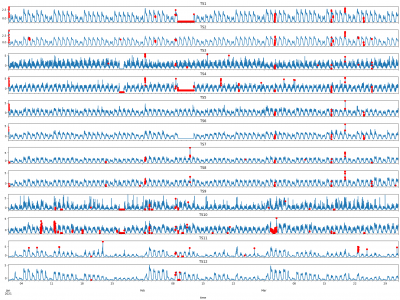Anomaly Detection
In the contemporary cybersecurity landscape, robust attack detection mechanisms are important for organizations. However, the current state of research in Software-Defined Networking (SDN) suffers from a notable lack of recent SDN-OpenFlow-based datasets. Here we introduce a novel dataset for intrusion detection in Software-Defined Networking named SDNFlow. The dataset, derived from OpenFlow statistics gathered from real traffic, integrates a comprehensive range of network activities.
- Categories:
 1806 Views
1806 Views
# Datasets for stage 3
The datasets were collected from a software-based simulation environment simulating a small-scale IEC 61850-compliant substation with both the primary plant and the process bus.
The datasets consist of 148 attack scenarios, each scenario includes two benign behaviours (fault-free behaviours and emergency behaviours) and one type of malicious behaviour.
- Categories:
 182 Views
182 ViewsWe define personal risk detection as the timely identification of when someone is in the midst of a dangerous situation, for example, a health crisis or a car accident, events that may jeopardize a person’s physical integrity. We work under the hypothesis that a risk-prone situation produces sudden and significant deviations in standard physiological and behavioural user patterns. These changes can be captured by a group of sensors, such as the accelerometer, gyroscope, and heart rate.
- Categories:
 844 Views
844 Views
As the harmful effects of climate change on human society increase, the analysis of abnormal weather is becoming an important issue. Therefore, this work provides the Korean weather dataset, including the anomaly score measurements by using seven different methods. In this dataset, seven types of weather data for each day in 64 Korean cities from 2010 to 2020 are provided by Weather Radar Center in Korea Meteorological Administration.
- Categories:
 301 Views
301 ViewsA recent study [1] alerts on the limitations of evaluating anomaly detection algorithms on popular time-series datasets such as Yahoo, Numenta, or NASA, among others. In particular, these datasets are noted to suffer from known flaws suchas trivial anomalies, unrealistic anomaly density, mislabeled ground truth, and run-to-failure bias. The TELCO dataset corresponds to twelve different time-series, with a temporal granularity of five minutes per sample, collected and manually labeled for a period of seven months between January 1 and July 31, 2021.
- Categories:
 832 Views
832 ViewsIman Sharafaldin et al. generated the real time network traffic and these are made available at the Canadian Institute of Cyber security Institute website. The team of researchers published the network traffic data and has made the dataset publicly available in both PCAP and CSV formats. The network traffic data is generated during two days. Training Day was on January 12th, 2018 and Testing Day was on March 11th, 2018.
- Categories:
 6416 Views
6416 ViewsSmart homes contain programmable electronic devices (mostly IoT) that enable home automation. People who live in smart homes benefit from interconnected devices by controlling them either remotely or manually/autonomously. However, high interconnectivity comes with an increased attack surface, making the smart home an attractive target for adversaries. NCC Group and the Global Cyber Alliance recorded over 12,000 attacks to log into smart home devices maliciously. Recent statistics show that over 200 million smart homes can be subjected to these attacks.
- Categories:
 3440 Views
3440 Views
The dataset contains performance values, Area Under the ROC Curve (AUC) and Average Precision (AP), of popular anomaly detection (AD) algorithms taken over a set of 9k AD benchmark datasets.
Datasets were initially published with the following paper:
Kandanaarachchi, S., Muñoz, M. A., Hyndman, R. J., & Smith-Miles, K. (2020). On normalization and algorithm selection for unsupervised outlier detection. Data Mining and Knowledge Discovery, 34(2), 309-354.
- Categories:
 411 Views
411 Views
For Internet-based service companies, anomaly detection on data streams is critical in troubleshooting, seeking to maintain service quality and reliability. Most of known detection methods have an underlying assumption that the data are always continuous. In practical applications, however, we learn that many real-world data are sporadic. It incurs particular challenges for the task of anomaly detection, for which the common preprocessing of downsampling on sporadic data can omit potential anomalies and delay alarms.
- Categories:
 43 Views
43 Views
Microarchitectural attacks have become more threatening the society than before with the increasing diversity of attacks such as Spectre and Meltdown. Vendor patches cannot keep up with the pace of the new threats, which makes the dynamic anomaly detection tools more evident than before. Unfortunately, hardware performance counters (HPCs) utilized in previous works lead to high performance overhead and detection of a few microarchitectural attacks due to the small number of counters that can be profiled concurrently.
- Categories:
 55 Views
55 Views



